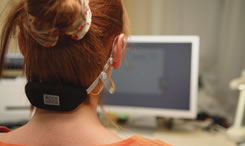Innovations in Accessibility
I’m continually impressed by the ways in which both hardware and software technology serve to enable basic access to computing for all people – including those with disabilities.
Case in point – a new hardware setup, designed for people with spinal cord injuries that allows them to control their computer with their tongue (via engadget, with hat tip to James Craig).
ACCS [Alternative Computer Control System] is placed in a person’s mouth (and comprises a tongue controlled directional command module along with 12 additional commands). It does not interfere with breathing, talk and consumption of fluids.
From the sounds of it, this isn’t “mainstream technology” (it appears they are still looking for investors). Nonetheless, it shows interesting potential and may be a sign of things to come.


This utterly fascinates me and inspires me to think differently when implementing accessibility solutions. I often get concerned that we’re in a rut when it comes to making web sites and applications accessible – we just use what we know, even if it isn’t the best solution.
I was also intrigued when i saw on the same site: GRAViTONUS for Gamers. This is something that I mentioned in my keynote at Web Directions South last year. Maybe we need to look beyond what we know and find inspiration from other “worlds” – the gaming world, for instance. Gamers have ridiculously powerful input devices that allow for incredibly complex maneuvers.
What can we take from that world of gaming as it relates to human computer interaction and apply to our world of accessibility? Perhaps nothing, but we need to at least keep our eyes and minds open and ask the question.
Photos used with permission
Technorati Tags: assistive technology, accessibility
2 Responses
Comment by gavin j — Feb 25 2007 @ 7:12 pm
Thanks for posting this Derek,
about a year ago a long-time friend of the family had a disabling spinal injury when his helicopter crashed. There was a concern that he would have no mobility below the neck (Thankfully, since then he has regained some movement in his hands). Not long after the accident the search was on for ways to keep him connected and most of the solutions were voice controls of one kind or another.
It is encouraging to see people working on improvements and innovations to controls for quadriplegics.

Comment by Adam H — Feb 23 2007 @ 8:17 am
That is very impressive technology! I wonder how long it would take to get comfortable with the control. It would probably be pretty easy once you get the hang of it but I can’t imagine they would have the ability to do acceleration of the pointing device which could get frustrating. I guess it could react to more or less pressure on the receptor.
I don’t often get a chance to see the latest in accessibility technology, thanks for bringing this up.